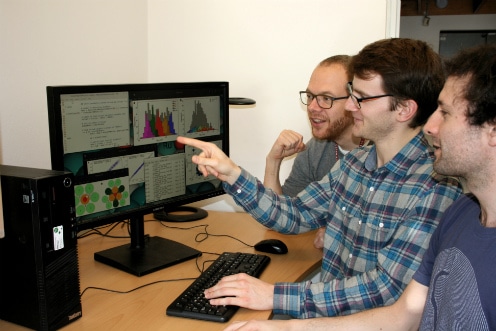Mar 6 2019
In the next three decades, the use of wind and solar power ought to be increased two-fold to meet the need for clean energy across the globe.
 Professor Jan Rossmeisl with the PhD students, Jack K. Pedersen and Thomas A.A. Batchelor. (Image credit: University of Copenhagen)
Professor Jan Rossmeisl with the PhD students, Jack K. Pedersen and Thomas A.A. Batchelor. (Image credit: University of Copenhagen)
Therefore, catalysts that are capable of certainly storing solar and wind energy in fuels and chemicals will play a markedly major role. But the catalysts that are used at present are usually expensive and inefficient.
Presently, scientists from the University of Copenhagen and DTU have devised a technique through which finer and low-priced catalysts can be easily obtained. The study results were recently published in the journal JOULE.
With the increase in world population from the existing figures of 7.3 billion to about 9.7 billion by 2050 (according to UN statistics), in the next three decades, there will be a two- to three-fold increase in the world’s demand for energy.
It is not sufficient to increase the capacity of solar and wind power to replace fossil fuels. Although both sources meet the environmental sustainability requirement, they are unsteady due to their dependence on unforeseeable weather conditions.
Due to this instability, electrolysis and catalysts have become increasingly significant, and it is hoped that they would be capable of ensuring a stable energy supply. Furthermore, in the chemical industry, catalysts are used for several purposes, such as the conversion of toxic exhaust gases from automobiles to the conversion of N2 from the atmosphere for fertilizers.
Catalyst and Electrolysis
During a chemical reaction, the role of a catalyst is to help in the conversion of chemical substances, and an efficient catalyst is capable of providing a quick, cheap, and efficient pathway for the reaction. Electrolysis is a technique that uses electricity to separate a substance.
Still a Long Way to Go
There is still a long way to go in the development of catalysts that can be used for e.g. fuel cells, storage of solar and wind energy and new environmentally friendly fuels. The catalysts that exist today are not good enough to ensure a green transition.
Jan Rossmeisl, Professor, Department of Chemistry, University of Copenhagen
Together with Jack K. Pedersen and Thomas A.A. Batchelor (PhD students), Jan Rossmeisl is seeking “the famous needle in the haystack” among a new generation of catalysts.
However, this is not an easy thing to achieve.
It is difficult to find the right alloy of metals for catalysts among infinitely many possibilities—despite today’s supercomputers. Finding the best alloys would take a lifetime. We use the so-called high-entropy alloys, which are random mixtures of many different elements, as a starting point and we have developed computer models based on machine learning. In this way, it becomes easier to sort the myriad of combinations of alloys and find those that can solve the problem of converting and storing solar and wind energy efficiently.
Jan Rossmeisl, Professor, Department of Chemistry, University of Copenhagen